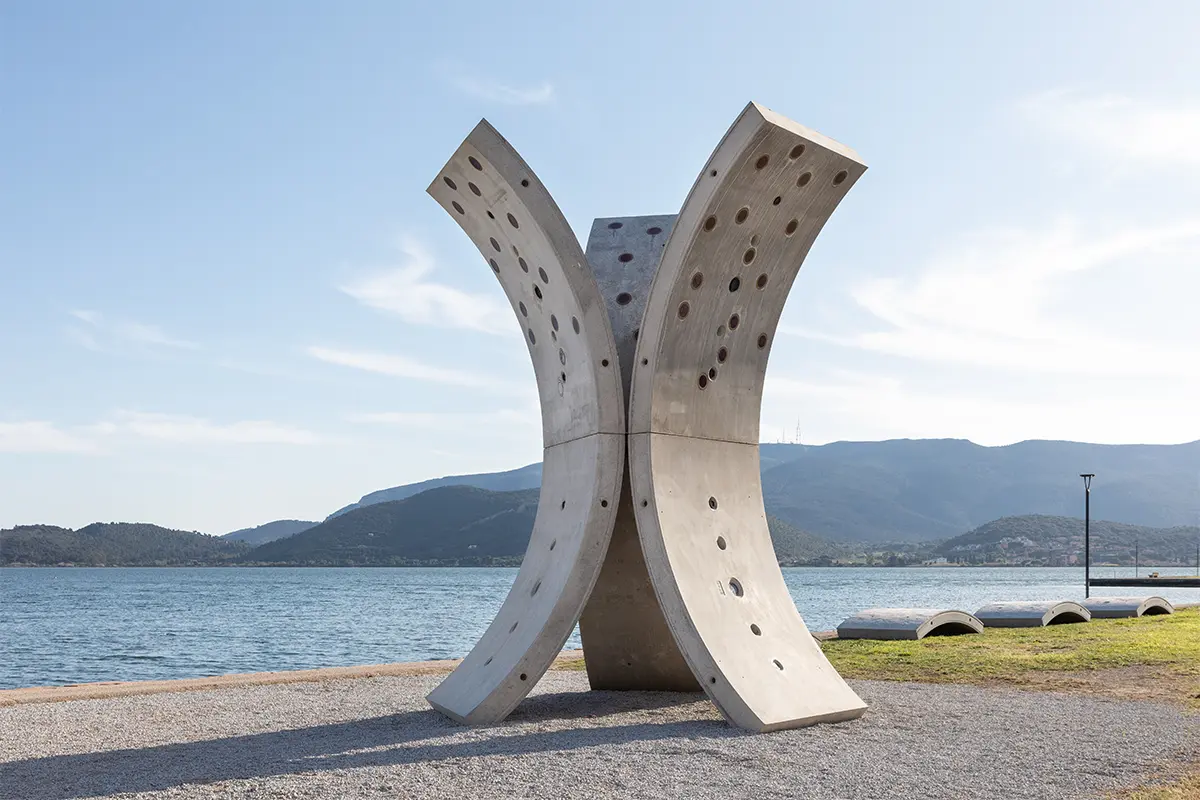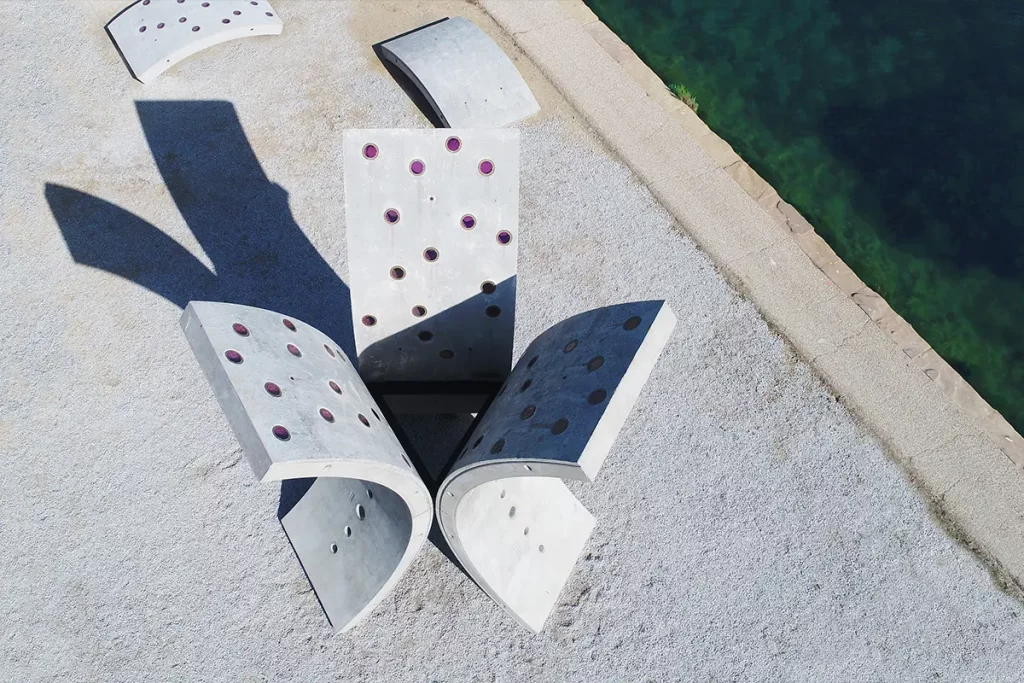The 2023 edition of the Tuscan festival features international artists Virginia Overton, Claudia Comte and Giuseppe Gallo with three site-specific installations
Hypermaremma launches its fifth edition
On April 8th Hypermaremma will launch its fifth edition with Tulip, a monumental sculptural work created by American artist Virginia Overton. Hypermaremma is an artistic festival that takes place every year in Maremma, a region located in the south of Tuscany, renowned for its unspoiled nature and seaside villages. From spring to fall, this territory hosts a variety of works of art and performances, whose aim is to promote a synergy between artists, institutional partners, local private companies and the general public.
Lasting until October 8th, the 2023 edition of Hypermaremma will feature three international artists, whose on-site installations differently focus on and dialogue with the idea of nature.
Hypermaremma: a contemporary experience of Tuscany
Project Hypermaremma was first launched in 2019 by gallerists Carlo Pratis, Giorgio Galotti, and Matteo d’Aloja and counts on a number of ambassadors and supporters around Italy. Their wish was to add a contemporary twist – a hype, indeed – to a territory traditionally characterized by slowness, while at the same time rediscovering the places and the history of Maremma. Tradition and innovation merge in the project, starting from its logo, a font on a yellow background, which is the iconic color of the signs of local village festivals.
Moreover, Hypermaremma wants to promote a new way of enjoying art. Visitors are not invited to close in a gallery, but to wander through the territory, to look for works of art in the middle of natural landscapes: nature and culture support and enhance each other. Every year Hypermaremma proposes different initiatives in different locations, but its goals and values remain unchanged: bring people and skills together to generate ideas, raise awareness of environmental sustainability and promote art as a means of communication.
Virginia Overton’s Tulip opens the festival
Opening this year’s edition of Hypermaremma is Virginia Overton’s Tulip, a six meter high sculpture that will be placed outside of the Polveriera Guzman in collaboration with White Cube Gallery. Located in Orbetello, near Grosseto, the Polveriera was built in 1692, under Spanish rule, by the Flemish architect Ferdinand De Grunembergh. During the centuries, it was employed as a gunpowder store and in 1860 Giuseppe Garibaldi and his men armed themselves here before starting the expedition that would free and unite Italy. Since 2004 the building has been turned into an archaeological museum, where Etruscan, Roman and Medieval artifacts found in the surrounding area are displayed. The Polveriera faces the Orbetello lagoon, whose waters will reflect the geometric structure of the Tulip. The idea is to promote an interaction between contemporary art, sculpture, the architecture of the Polveriera Guzman and the natural landscape of the lagoon.
At the Fifty-ninth Venice Biennale as part of The Milk of Dreams exhibition
Presented for the first time at the Fifty-ninth Venice Biennale as part of The Milk of Dreams exhibition, Overton’s work consists in three interlocked segments, arranged back to back, which open towards the sky taking on the form of a tulip. The sculpture is made from pre-existing molds usually used for the construction of large tunnels and dotted with circular pink glass “windows”. The tulip will be surrounded by benches made from the same material, to invite people to move around the sculpture and experience different perspectives.
Overton never chooses her materials just according to their esthetic effect, but also because of their history and future potential. With a strong interest in re-contextualizing and appropriating, she often uses recycled or readymade materials found in the everyday detritus of the urban landscape to dialogue with the places her works are located in, with their geographical position and history.
Overton’s public art always holds a symbolic function within the collective space it explores and often calls attention to the demands of scale and gravity.
Claudia Comte: in nature nothing exists alone
«In nature nothing exists alone» – the words of an over hundred-meter-length wooden writing made by Swiss artist Claudia Comte. Inaugurated in summer 2022 and realized in cooperation with Italian contemporary art magazine Cura, this site-specific installation will be part of the fifth edition of Hypermaremma and remain open to the public until September 15th.
With her work Comte quotes American biologist and zoologist Rachel Carlton, whose ecological message she wishes to spread, being herself devoted to themes such as climate change, ecology and global pollution. In an essay entitled Silent Spring Carlton wrote: «Nothing ever exists entirely alone: everything is in relation to everything else». What she meant to say was that every action ever performed in the terrestrial ecosystem always has an impact on all the creatures that inhabit it – a warning to human beings, whom she accused of taking advantage of all the other species. She came up with this theory while doing research on the damages caused by the indiscriminate use of DDT and pesticides to nature, animals and also – through the food chain – to human health.
The relationship between man and nature: Claudia Comte
By making Carlton’s words visible and concrete, Comte wishes to give rise to a reflection on the relationship between man and nature, as well as on the relation between humans’ actions and the life cycle of the planet. To do so, she used pine logs from Mount Amiata, the largest lava domes in the Amiata lava dome complex, located in the south of Tuscany, within the provinces of Grosseto and Siena, where a method of selective cutting is employed to allow for a controlled forest regeneration. Afterwards, the logs will be reused in future carpentry works to avoid waste.
In nature nothing exists alone is the largest of a series of works by Comte consisting in wooden writings and the only one that is not an onomatopoeia or a palindrome, being the others Hahaha, Now I won, Wooow, Me we. Each of these large-scale works derives inspiration from the artist’s own biography: she was born and raised in a Swiss country village, surrounded by forests, ancient trees and biomorphic forms, which she has always tried to translate into her art. Comte combines such natural inspirations with modernist geometry, traditional craftsmanship and industrial technologies to bring art back to the ecological world. In such a symbiotic process she wishes to make the public aware of nature being at the same time powerful and fragile, thus requiring care, understanding and respect.
Each of Comte’s installations is specifically designed for the site it is displayed in, suggesting the idea that it embodies the spirit of that particular place, making it visible for those who are ready to observe.
Giuseppe Gallo’s jugglers play with harmony
The third installation featured in Hypermaremma’s 2023 edition will be I giocolieri dell’armonia (The harmony jugglers) by Italian artist Giuseppe Gallo. Inaugurated in April 2022 and visible until September 15th, the installation is located on the black seaside in front of the Tagliata di Arsedonia, a rock wall dotted with canals that make water flow from the port of the ancient Etruscan city of Cosa.
Here twelve anthropomorphic figures made of corten steel seem to walk in a row with the sea as a background. Each of these silhouettes is different and all together they narrate the history of the populations that inhabited Maremma through the centuries, joining in what may appear as a sort of dance between different ages of humanity. The installation basically talks of the territory with the territory. The dialogue with time – past, present and future – is a constant in Gallo’s work, something not granted in contemporary art. His characters are here “juggling” time, art and history.
The archetypal dualism of mankind
The artist also aims at representing the archetypal dualism of mankind, made of instinct and utopia. His figures are made of opposites, with dynamic bodies and static heads. Moreover, their head posture calls to mind the iconic image of the thinker or philosopher, injecting into the installation all the energy, both physical and mental, that precedes action.
The number of the figures is not random, as twelve embodies the completion of a cycle, a perfect totality, that same harmony evoked by the work’s title. Numbers always have a symbolic relevance in Gallo’s art and here other stylized symbols can be spotted. For example, the bull, which in ancient Greek culture embodied creative force and rebirth, is here an invitation to mankind to embrace nature instead of detaching from it. Similarly, the characters’ legs resemble paws as the artist thinks that human beings should preserve their animal parts.
Gallo’s work wishes not only to dialogue with history and natural landscape, but also with the public, who are called to join the jugglers in the procession of humanity they represent.
Hypermaremma
First launched in 2019 on the initiative of gallerists Carlo Pratis, Giorgio Galotti, and Matteo d’Aloja, Hypermaremma is an artistic festival that takes place every year in Maremma, a region in the south of Tuscany. It aims at creating a dialog between contemporary art and local territory and features on-site installations and performances.




















